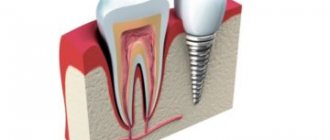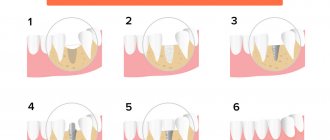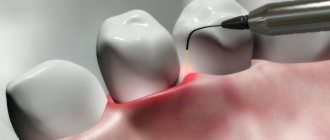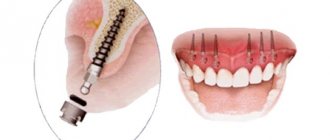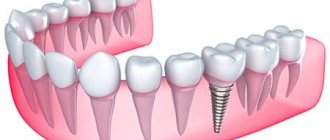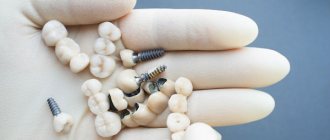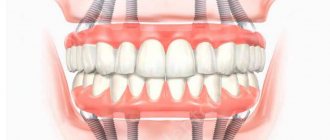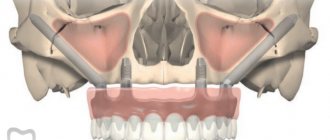Most people will lose teeth during their lifetime. There are many reasons for this: improper oral care, unfavorable external environment, untreated diseases. Even the absence of one tooth brings inconvenience to a person, because the load is transferred to neighboring ones, which causes them to shift and worsens the condition. The best way to eliminate the problem of lost teeth is implantation.
- 2 Indications and contraindications
- 3 Stages of dental implantation video
- 4 Possible complications
Preparatory
Implantation is a kind of surgical intervention that requires careful preparation. Sometimes, the duration of this stage can vary from one week to a month.
Experts carefully evaluate the possibility of the body accepting a foreign body.
Initial visit
Initially, a patient who wants to restore a completely lost tooth visits a dentist for a consultative purpose. The specialist visually examines the oral cavity, assesses the condition of the jaws, and finds out information about concomitant diseases.
Planning
After the examination, the dentist draws up a detailed plan for preparing for implantation. It includes diagnostics of the oral cavity and general condition of the body, as well as the necessary stages of treatment for problem teeth and periodontal diseases.
The duration of the preparatory period depends entirely on the individual characteristics of the patient and his medical history.
Diagnostics
In order to get an idea of the anatomical structure of the jaw bones, dentists prescribe the following examination methods:
- X-ray diagnostics – allows you to obtain an image detailing the condition of the area for implantation and the health of the root system of adjacent teeth;
- orthopantomogram - obtaining a panoramic image of the structure and volume of bone tissue as a whole;
- computed tomography is an examination technique that allows you to obtain a three-dimensional image of bone tissue. With its help, you can evaluate not only the structure, but also the density of the bone.
Positive and negative aspects of the method of silvering baby teeth, as well as alternative ways to prevent caries. Come here to find out what to do if your wisdom tooth is loose.
At this address https://dr-zubov.ru/krasota-i-uxod/otbelivanie/ofisnoe/lak-momentalnoe-sredstvo.html we offer you a closer look at dental varnish.
Taking tests
The necessary tests before implantation are usually scheduled no later than 2 weeks before the procedure.
In order to avoid a number of complications of surgical intervention, the patient is required to provide the results:
- general blood and urine analysis;
- tests for fibrinogen and prothrombin;
- analysis of blood clotting and platelet formation;
- the presence of antibodies in the body to HIV, syphilis and various hepatitis;
- biochemical blood tests, including blood glucose levels.
Depending on the individual characteristics of the body, the patient may also be assigned a consultation with other highly specialized specialists who may recommend a number of additional examinations.
Sanitation of the oral cavity
After the diagnostic results have excluded all possible contraindications to implantation, the specialist begins treatment of all problems of the oral cavity.
At this stage, professional cleaning is carried out, teeth that have undergone a carious process are filled, and all sources of inflammation and infection are eliminated. Bone tissue restoration
Sanitation of the oral cavity alone is not enough to begin implantation of a titanium root.
The condition of the jaw bone plays an important role in carrying out prosthetics using the universal method. The base for the implant must have a standard density and height.
Especially, areas that have been empty without a tooth for quite a long time need restoration of bone tissue.
Its compaction is ensured by using one of the following methods:
- Guided regeneration is a technique of implanting artificial material or natural tissue in order to restore the bone parameters necessary for implantation. Prosthetics are allowed 4 months after the procedure.
- Replanting a bone block taken from another area of the body . The technique is relevant for the development of the resorption process of bone tissue. This method allows implantation to be carried out after 5 months.
- Sinus lifting is a technique whose purpose is to raise the height of the mucous membrane of the bottom of the maxillary sinus to increase the volume of bone tissue of the upper jaw. The average waiting time between this procedure and the installation of the implant is 5 months.
What is a sinus lift - Dr. Levin D.V. will tell you in detail. in the following video:
Stage 5. Installation of prostheses
This stage can be called the most pleasant, since it is here that the patient receives what the implantation was for - dental crowns. Depending on the situation, the dentist selects the most optimal option: a single crown, a bridge, or a removable denture. Depending on the patient’s financial capabilities and his individual characteristics, they can be made of various materials and fixed to the prosthesis abutment. Attention is paid not only to their functionality, but also to the aesthetic component (especially when it comes to restoring the front teeth).
Do you also need dental restoration services? Contact the Good Hands clinic in Lyublino! We have experienced implantologists who will tell you in detail about each stage of prosthetics and select the most optimal treatment option for you. You can sign up for a free consultation by phone right now!
In our clinic you can get a free dental consultation!
Surgical
The process of implanting an artificial root into the gum does not require much time; on average, surgical intervention lasts 30 - 50 minutes.
The entire procedure is divided into several successive steps. Excision of gums and periosteum
First of all, the specialist performs a series of procedures to expose the bone tissue. Before proceeding with the operation, the oral cavity is carefully treated with an antiseptic.
Then, using a patchwork method, an incision is made into the upper ball of the gum - the alveolar ridge. After which the mucous membrane and periosteal tissue are subjected to detachment.
Previously, gum excision was carried out only with a scalpel. Today, a laser can be used for this purpose, which causes less significant injuries and prevents large blood losses.
Formation of the bed
Before directly installing the implant, the specialist needs to create a hole in the bone tissue.
To do this, using drills of various diameters, he drills out a bed whose parameters will correspond to the dimensions of the artificial root.
First, the length of the recess is adjusted, which is usually 2 mm.
Then the bed is expanded and special taps are used to cut a thread into the hole that matches the thread of the implant.
Screwing in the implant
In practice, two types of implants are used: cylindrical and screw. The first ones are installed in the prepared recess using a special tool and a surgical hammer.
The second ones are mounted with a screwing device.
As a rule, the pin is driven into the bone until the distance between it and the lower edge of the alveolar ridge is at least half a centimeter. After its installation, a special plug is placed on it, which prevents the implant cavity from filling with gum tissue.
If a gap forms between the gum and the artificial root, it is filled with osteoconductive or osteoinductive material.
In some clinics, to create tighter contact between the tissues of the oral cavity and the implant, the pin is treated with a special substance before installation.
Gum stitching
The final stage of the surgical intervention is to place all the flaps of oral tissue in their original position so that they completely cover the surface of the plug and the entire body of the implant..
After this, the wound is sutured with interrupted surgical sutures, which are removed approximately 5-7 days after the operation.
It is worth noting that the installation of an implant can also be carried out immediately after the removal of a tooth that cannot be restored.
Advantages and disadvantages of one-stage dental implantation
pros
- One operation is performed, waiting time is reduced
- Simplified installation process
- Minimal loss of mucous and bone tissue after surgery
- If the technology is followed, the percentage of successful operations is 99.6%
Minuses
- Contraindicated in chronic inflammation, diseases
- Not performed if there is insufficient bone
- Strict rehabilitation period, frequent visits to the implantologist
For a favorable outcome, entrust the operation to a surgeon with extensive experience in this protocol.
Securing the healing abutment
In order to bring the appearance of the implant as close as possible to a natural tooth, during prosthetics, a gum former is installed into the body of the artificial root, the purpose of which is to create the contour of the tissue surrounding the crown.
With one-stage implantation, this manipulation is carried out immediately after screwing in the titanium structure. In the classic version of prosthetics, the gum former is installed 3-6 months after installation of the implant.
This element of the integral structure is a screw titanium cylinder, which is mounted into the artificial root of the future tooth. The manipulation is carried out under local anesthesia.
Initially, the specialist makes an incision in the gum over the plug, which he removes and screws the former into its place. Afterwards, sutures are placed around this element, so that its upper surface protrudes above the mucosa.
After about two weeks, the former is overgrown with a dense ball of gum tissue, which will ensure the functioning of the implant.
Features of Splat children's toothbrushes, their types and purpose. This article is all about macroglossia disease, its causes and treatment methods.
Follow the link https://dr-zubov.ru/krasota-i-uxod/sredstva/ershiki-dlya-zubov/chetyre-vazhnyx-pokazatelya-pri-vybore.html to find out prices for dental brushes from popular manufacturers.
Abutment installation
After the required volume of tissue surrounding the artificial tooth has been formed, the former is replaced with an abutment.
In general, the operation principle of manipulation is not very different from changing the plug. The only difference is that there is no need to make an incision into the gum tissue.
After installing the abutment, all preparatory work for the direct installation of the crown is completed.
In the video, watch the stages of one-stage classical implantation.
Stock
-22%
New tooth in 1 day - implant and prosthesis immediately!
45000 rub. 35,000 rub.
get -62 %
Metal-free dental crown made of zirconium dioxide 25,000 rub.
9500 rub.
get -40 %
Promotion for installation of veneers!
30000 rub. 18,000 rub.
get -62 %
Metal-free dental crown made of zirconium dioxide 25,000 rub.
9500 rub. get
Orthopedic
2 weeks after installing the base for the crown - the abutment - prosthetics are performed. The implantologist, together with the orthopedist, completely recreates the anatomical integrity of the dentition.
The following types of prostheses can be installed on an artificial root:
- fixed;
- removable;
- conditionally removable;
- combined.
Taking impressions
In order for craftsmen to make an individual prosthesis for the patient’s oral cavity, dentists take impressions using special material.
Before the final installation of the artificial tooth body, the structure is repeatedly tried on.
If necessary, its parameters are adjusted until the prosthesis no longer causes discomfort in the patient. On average, the production of a structure takes from 2 to 4 weeks.
Installation of the prosthesis
The subtleties of the process of installing a prosthesis depend on its type. Single crowns or 2-3 single bridge structures are attached directly to the abutment using adhesive material.
Installation of a prosthesis, which can replace almost the entire dentition, is carried out using special locks that are built into the crowns.
However, the cheapest method of fixation is to screw the tooth body into the implant using screws implanted into the prosthesis.
For details about the stages of classical implantation, see the video.
Indications and contraindications
The dentist, based on the patient’s medical history and examination, determines indications and contraindications for dental implantation.
Testimony and video:
- a single defect in the dentition with healthy neighboring teeth that will not need to be ground down;
- missing two or three teeth in a row. In this case, there is also no need to prepare adjacent teeth;
- with the loss of the last teeth in a row. With other types of prosthetics, this defect causes difficulties. For an implant, the presence of nearby teeth does not matter;
- complete absence of teeth. In this case, dentures that are supported by implants or more stable attachments of removable dentures are indicated. If the patient is not mentally ready to remove the denture from the mouth, then it is better to use dental implantation;
- in case of hypersensitivity to the main component of dentures (acrylate) or with a gag reflex. That is, the patient will not be able to wear a removable denture, which means that the choice should be made on implantation.
Contraindications:
Compared to installing a prosthesis, there are many more contraindications for implantation.
Relative contraindications:
- acute and subacute forms of periodontitis;
- increased tooth wear;
- malocclusion;
- bruxism (teeth grinding);
- anatomical features of the jaw structure, which exclude the possibility of surgical intervention. For example, missing teeth or bone atrophy;
- the presence of artificial implants in other parts of the body (heart valves, artificial joints, screws, pacemakers, etc.);
- Pregnancy and breastfeeding are temporary contraindications for dental implantation.
Absolute contraindications:
- blood diseases;
- diabetes;
- chronic oral diseases;
- lesions of the musculoskeletal system, which reduce the regenerative ability of the body;
- damage to the peripheral and central nervous system;
- chronic diseases (tuberculosis, rheumatism and others).
Rehabilitation period
Implantation is a prosthetic technique that requires a rehabilitation period. Often, the patient’s body recovers within 5 months.
All this time you must follow certain rules:
- Conduct preventive examinations at the dentist at intervals prescribed by the implantologist;
- during hygiene procedures, you should use a brush of medium hardness and apply minimal pressure of the bristles to the area subject to implantation;
- the use of aseptic rinses and waxed dental floss is prohibited;
- solid food intake should be kept to a minimum.
Reviews
Implantation is a universal method of restoring the integrity of the dentition, which in terms of cost is not suitable for every patient in a dental clinic. In addition, it is not a fact that your body will accept a foreign body.
Have you ever experienced implantation? How long did the prosthetics process take you in total? Are you satisfied with the result? Leave your comment. We are sure that your experience will be useful to many of our readers.
If you find an error, please select a piece of text and press Ctrl+Enter.
